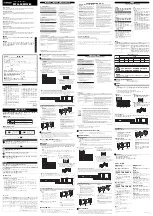
14
IOM-3200
Cashco, Inc. declares that the products listed in the table below has been found to comply with the Essential Health and
Safety Requirements relating to the design and construction of products intended for use in potentially explosive atmospheres
given in Annex II of the ATEX Directive 2014/34/EU and given in Schedule 1 of The Equipment and Protective Systems
Indented for Use in Potentially Explosive Atmospheres Regulations 2016. Compliance with the Essential Health and Safety
Requirements has been assured by compliance with EN ISO 80079-36:2016 and EN ISO 80079-37:2016. The product will
be marked as follows:
II 2 G
Ex h IIB T6... T1 Gb
1000ATEXR1 X
The ‘X’ placed after the technical file number indicates that the product is subject to specific conditions of use as follows:
1. The maximum surface temperature depends entirely on the operating conditions and not the equipment itself. The
combination of the maximum ambient and the maximum process medium temperature shall be used to determine the
maximum surface temperature and corresponding temperature classification, considering the safety margins described
prescribed in EN ISO 80079-36:2016, Clause 8.2. Additionally, the system designer and users must take precautions to
prevent rapid system pressurization which may raise the surface temperature of system components and tubing due to
adiabatic compression of the system gas. Furthermore, the Joule-Thomson effect may cause process gases to rise in
temperature as they expand going through a regulator. This could raise the external surface temperature of the regulator
body and the downstream piping creating a potential source of ignition. Whether the Joule-Thomson effect leads to
heating or cooling of the process gas depends on the process gas and the inlet and outlet pressures. The system
designer is responsible for determining whether the process gas temperature may raise under any operating conditions.
2. Where the process medium is a liquid or semi-solid material with a surface resistance in excess of 1G
Ω
, special
precautions shall be taken to ensure the process does not generate electrostatic discharge.
3. Special consideration shall be made regarding the filtration of the process medium if there is a potential for the process
medium to contain solid particles. Where particles are present, the process flow shall be <1m/s (<3.3 ft/s) in order to
prevent friction between the process medium and internal surfaces.
4. Effective earthing (grounding) of the product shall be ensured during installation.
5. The valve body/housing shall be regularly cleaned to prevent build up of dust deposits.
6. Regulators must be ordered with the non-relieving option (instead of the self-relieving option) if the process gas they are
to be used with is hazardous (flammable, toxic, etc.). The self-relieving option vents process gas through the regulator
cap directly into the atmosphere while the non-relieving option does not. Using regulators with the self-relieving option
in a flammable gas system could create an explosive atmosphere in the vicinity of the regulator.
7. Tied diaphragm regulators with outlet ranges greater than 7 barg (100 psig) should be preset to minimize the risk that
improper operation might lead to an outboard leak and a potentially explosive atmosphere.
8. All equipment must only be fitted with manufacturer’s original spare parts.
9. Ensure that only non-sparking tools are used, as per EN 1127-1, Annex A.
ATEX DIRECTIVE 2014/34/EU and THE EQUIPMENT AND PROTECTIVE SYSTEMS INTENDED FOR USE IN
POTENTIALLY EXPLOSIVE ATMOSPHERES REGULATIONS 2016
IOM ADDENDUM:

































